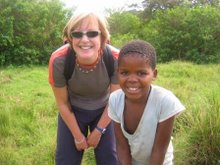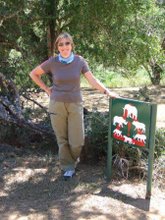Unlike many border crossings, there were no money changers or taxis on either side, so we began walking - taking our lead from the older gentleman who stoically strode on in the hot sunshine. We'd probably walked for half an hour when another government bakkie (the Botswana govt this time), stopped and gave us a lift - we were pretty relieved as there had been no other traffic at all, and Shakawe, the town we had to get to, was about 15km away.

Being delivered to the bus depot over the border in Botswana.
We were delivered to the bus depot and pointed to the bus to Maun, our final destination for the day, and about 300km away. So far so good - the bus left an hour later, so we had time to change some money and get some supplies for the trip, and about six hours later (in the dark unfortunately) we were deposited at Maun. Here there were loads of taxis, and we took one to Camp Crocodile, about 15km from town. This was another long day of travelling, and we were really tired by the time we arrived. However, they were so nice - the bar was open, and serving meals, and while we were eating we were informed that we'd been "upgraded", from a tent site to a bungalow. Fantastic. The bungalow is built with reeds, has electricity, its own bathroom, and a big bed with mosquito net built on a platform above the floor. It was Saturday night, but no partying for us. We were tucked up and sound asleep by 9.30 - loving Botswana already!
But here, it's all about the Delta and we have just got back from an overnight mokoro trip. This means we have been poled (or punted if you're from Christchurch!) down a maze of little creeks with reeds frequently flicking us in the face, while having all kinds of birds, frogs and dragonflies pointed out to us by our trusty poler who can see things we just can't. It was a great trip tho', made particularly good because our guide, Mike, really knew his stuff and could also speak passable English. Our only quibble was his tendency to burst into rounds of "Pole, pole, pole the mokoro gently down the stream..." - someone must have told him this was something that tourists would warm to, hmmm. Spotted lots more game, but it seems different when you're at water level and there's a herd of zebra cantering past, than when you're in a car. We also did a couple of walks, and believe me your level of alertness skyrockets when you're wandering about the grasslands of the Delta, known playground of lions (only heard, not seen), elephants (saw two herds of these, including one inquisitive young bull), hippos, hyenas and various other critters, armed only with Mike's copy of the Lonely Planet Southern Africa wildlife spotters guide. We spent the night under the stars, comforted by Mike's assurance that the hippos never come over this part of the river, and that the seemingly out of control bushfires nearby were also not a problem - "it's OK, there's a plan".


The polers gather round at the head of the river, and are allocated to tourists on a first come basis, all ruled over by a rather fierce Botswana woman with a clipboard.
We've only been in Botswana for a few days, and will probably only be here for a few more, but so far it's a very likable place. People have been kind and helpful, and I don't think anyone's ripped us off yet (tho' ignorance may be bliss in this regard). The place is full of dusty donkeys, which apparently are also eaten (this could account for their general cantankerousness), and, because of or in spite of the country's claim to one of the highest AIDS rates in the continent, colourful and plentiful poster and billboard campaigns extolling condom use, sexual abstinence and commitment to the use of anti retroviral drugs. This is a complete contrast to South Africa which has adopted a much more low key approach to public education on this issue.































